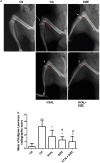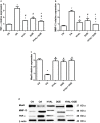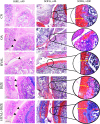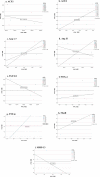Hyaluronic acid/diminazene aceturate combination ameliorates osteoarthritic anomalies in a rodent model: a role of the ACE2/Ang1-7/MasR axis
- PMID: 37725260
- PMCID: PMC10692272
- DOI: 10.1007/s10787-023-01335-5
Hyaluronic acid/diminazene aceturate combination ameliorates osteoarthritic anomalies in a rodent model: a role of the ACE2/Ang1-7/MasR axis
Abstract
The implication of the tissue-localized renin-angiotensin system (RAS) in the pathogenesis of osteoarthritis (OA) has been documented in the last decades. A combination of intraarticular (IA) corticosteroid and hyaluronic acid (HYAL) is approved for pain relief in patients with mild to moderate OA. Combining HYAL with an activator of angiotensin-converting enzyme 2, diminazen aceturate (DIZE), was evaluated in this study for its therapeutic potential. Monosodium iodoacetate was used to induce OA. The effects of daily administration of DIZE versus once-per-week IA injection of HYAL and a combination of both drugs for 21 days on OA deformities in rats' knees were observed. Evaluation of motor activities, pain, and inflammatory response was done using rotarod, knee bend, and knee swelling tests. RAS components, inflammatory biomarkers, and oxidative stress mediators were measured in the knee joint. X-ray radiological examination and histopathological investigations were used to assess joint degeneration and regeneration. Levels of both inflammatory and oxidative markers in knee joint homogenate of OA rats rose, and these increments were mostly improved by the three therapies with a more prominent effect of the drug combination, an effect that was also reflected in the behavioral tests. RAS markers have shown better responsiveness to the combination therapy over both drugs individually, showing a pronounced increase in the angiotensin 1-7 amount. Both radiological and histopathology investigations came to confirm the biochemical results, nominating a combination of HYAL and DIZE as a possible therapeutic option for OA.
Keywords: Diminazene aceturate; Hyaluronic acid; Inflammatory mediators; Osteoarthritis; Oxidative stress; Renin-angiotensin system.
© 2023. The Author(s).
Conflict of interest statement
The authors have no relevant financial or non-financial interests to disclose.
Figures









Similar articles
-
Diminazene aceturate or losartan ameliorates the functional, radiological and histopathological alterations in knee osteoarthritis rodent model: repurposing of the ACE2/Ang1-7/MasR cascade.J Exp Orthop. 2023 Oct 25;10(1):107. doi: 10.1186/s40634-023-00673-1. J Exp Orthop. 2023. PMID: 37878123 Free PMC article.
-
Angiotensin-converting enzyme 2 (ACE2) activator diminazene aceturate ameliorates endotoxin-induced uveitis in mice.Invest Ophthalmol Vis Sci. 2014 May 22;55(6):3809-18. doi: 10.1167/iovs.14-13883. Invest Ophthalmol Vis Sci. 2014. PMID: 24854854 Free PMC article.
-
The ACE2 activator diminazene aceturate ameliorates colitis by repairing the gut-vascular barrier in mice.Microvasc Res. 2023 Jul;148:104544. doi: 10.1016/j.mvr.2023.104544. Epub 2023 Apr 29. Microvasc Res. 2023. PMID: 37127063
-
The potential actions of angiotensin-converting enzyme II (ACE2) activator diminazene aceturate (DIZE) in various diseases.Clin Exp Pharmacol Physiol. 2020 May;47(5):751-758. doi: 10.1111/1440-1681.13251. Epub 2020 Jan 28. Clin Exp Pharmacol Physiol. 2020. PMID: 31901211 Review.
-
Diminazene Aceturate, an angiotensin converting enzyme 2 (ACE2) activator, promotes cardioprotection in ischemia/reperfusion-induced cardiac injury.Peptides. 2022 May;151:170746. doi: 10.1016/j.peptides.2022.170746. Epub 2022 Jan 13. Peptides. 2022. PMID: 35033621 Review.
References
-
- Ayub S, Kaur J, Hui M, Espahbodi S, Hall M, Doherty M, Zhang W. Efficacy and safety of multiple intra-articular corticosteroid injections for osteoarthritis—a systematic review and meta-analysis of randomized controlled trials and observational studies. Rheumatology. 2021;60:1629–1639. doi: 10.1093/rheumatology/keaa808. - DOI - PubMed
MeSH terms
Substances
LinkOut - more resources
Full Text Sources
Miscellaneous
